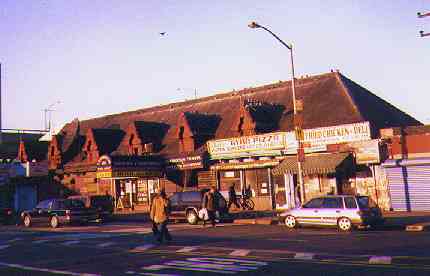Hunts Point Station
(now defunct New York, New Haven, and Hartford Station)
Hunts Point Avenue, east of the Bruckner Expressway
Architect: Cass Gilbert.
General Construction: Robert J. Mahoney
The New York, New Haven, and Hartford Railroad Co. built the Hunts Point station in 1909 for its “suburban” Harlem River Branch line. With the breakup of many large Bronx estates around this time, the company anticipated tremendous growth and investment potential for the sparsely settled Bronx. The company had ambitious plans for upgrading its branch and constructing a series of impressive railroad stations stretching from 132nd Street, in the lower Bronx, up to Westchester County’s New Rochelle. The architect Cass Gilbert (1859-1934) was commissioned to build the stations. Hunts Point was one of his nine stations built in the Bronx. Gilbert, then president of the American Institute of Architects, had just completed the Custom House at Bowling Green and would soon become even better known for the Woolworth Building.
Each of Gilbert’s Harlem line stations had different architectural styles. The Hunts Point station was French Renaissance in design. It had a wide overhanging hipped roof with pointed lacy dormer windows, spires, tiling and crenellations. Truss metal was used for reinforcement of the concrete roof. The building had chimneys on either side plus a signal tower with deep eaves (to block the sun) at the end. The street level’s main entrance was flanked by large triplet windows followed by smaller ones. Dressed red brick was faced with stucco, alternating with terra cotta. The building was solidly constructed and meant to last. Covered staircases led to the platform of the six-track high speed rail line beneath.
The railroad company gambled on its Harlem line. To avoid the fees charged for entering Grand Central Terminal the company expected customers to transfer in the Bronx to the Third Avenue Elevated line at Willis Avenue to get to Manhattan. Customers however preferred a straight run into Grand Central, instead of having to make the switch. The company assumed that the center of the city would move from midtown to 125th Street in Manhattan and even planned to construct its own station on the south end of the Harlem River. Plans changed in 1916, however, when the city’s zoning law restricted commercial development to below 59th Street. While ridership on the line was brisk during the rush hours, it had only a fraction of the projected passengers for intermediate schedules. Revenues declined and ultimately passenger service stopped by 1931. The line was insolvent by 1937 and efforts to reopen it failed.
The Hunts Point station is now a shell of its former self. The dormer windows still exist, but most of the structural details—chimneys, roof crenellations, spires, and terra cotta detailing are gone. Small businesses (eateries, beauty parlor, travel agency) are housed in the former station but the store awnings and roll down security gates mask the beauty of the original structure. The railroad tracks are now used by Amtrak and there has been discussion of reactivating passenger service for reverse-travel by area residents to Westchester, Connecticut and Queens.
Janet Butler Munch
